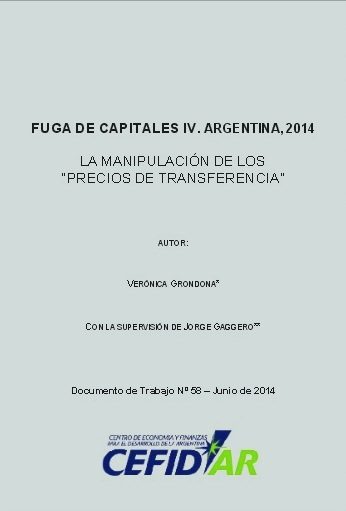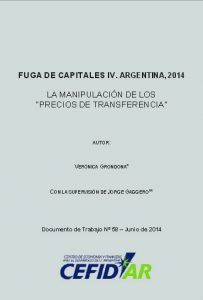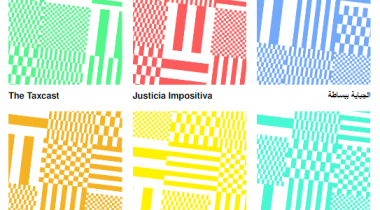
Nick Shaxson ■ Argentina’s capital flight and transfer pricing: new report

 A new report from Argentina’s CEFID-AR looks into the evolution of Argentina’s transfer pricing legislation. A short summary follows.
A new report from Argentina’s CEFID-AR looks into the evolution of Argentina’s transfer pricing legislation. A short summary follows.
From the dictatorship that began in 1976 and lasted until 1983, the OECD’s so-called ‘arm’s length method’ for tackling transfer pricing was explicitly incorporated into several relevant laws such as the Investment, Intellectual Property and Corporate Tax laws. The arm’s length method asserts that when related companies within the same corporate group trade across borders with each other, it is possible to establish an “arm’s length” price for the transaction, as if they were independent unrelated entities trading in a genuine market.
In many, if not the majority of, cases, calculating an arm’s length price requires that companies search for so-called ‘comparable’ market prices even when no such comparable prices exist in practice. This fiction underpins much of multinational corporate tax avoidance today. Before 1976, such transactions were analysed by the tax authorities and, where necessary, by the courts by applying an “economic reality” criteria, which considered payments for services, royalties and interests as equity movements between related parties.
By now the arm’s length criteria has become deeply rooted into national legislation: OECD methods were incorporated into the Corporate Tax Law in 1998. Tax authorities now seem to have serious difficulties in presenting successful cases to the tax courts, because the discussions almost inevitably focus on the eligibility of the chosen comparables. Ironically, even when it is obvious that comparable transactions and companies are not adequate because small independent companies never have the same cost structures as multinational companies, tax authorities nevertheless seem to be losing their cases time and again.
Moreover, legislative changes keep going in the same direction: since 2013 they have favoured the movement of capital to tax havens and secrecy jurisdictions that are considered to be “cooperative jurisdictions”. Eight of TJN’s 10 top secrecy jurisdictions are today considered to be “cooperative”: Germany, USA, Switzerland, Luxembourg, Cayman, Singapore, Japan and Jersey. It should be clarified that no relevant information for transfer pricing purposes has been obtained through the agreements signed with these jurisdictions. Nevertheless, because they are “cooperative”, no transfer pricing documentation needs to be presented in cases in which a company in Argentina has activities with a said-to-be unrelated party in such jurisdictions. And the so-called Sixth Method (that requires the prices of commodities to be compared with publicly known commodity prices at the shipping date) is not even required to be applied in such cases either.
The research does not measure the impact of transfer pricing manipulation in capital flight; that will be the subject of a second study on this topic.
This research was carried out by Veronica Grondona, under the supervision of Jorge Gaggero, on Argentina’s transfer pricing manipulation and capital flight, (In Spanish, Fuga de Capitales IV. Argentina, 2014. La manipulación de los “precios de transferencia”) It was produced for CEFID-AR (Center for Economic and Financial Development of Argentina) and carried out in collaboration with “Systems of Tax Evasion And Laundering” (STEAL), a project (#212210) financed by the “Research Council of Norway” (NUPI); being the issue of capital flight the focus of a work program of CEFID-AR (which began in 2006 and is planned to last until 2015), coordinated by Jorge Gaggero.
Related articles

Ireland (again) in crosshairs of UN rights body

New Tax Justice Network podcast website launched!

People power: the Tax Justice Network January 2024 podcast, the Taxcast

As a former schoolteacher, our students need us to fight for tax justice
Submission to the UN Special Rapporteur on extreme poverty and human rights’ call for input: “Eradicating poverty in a post-growth context: preparing for the next Development Goals”
17 January 2024
Submission to the Committee on Economic, Social Cultural Rights on the Fourth periodic report of the Republic of Ireland

The Corruption Diaries: our new weekly podcast

Tax Justice Network Arabic podcast #73: ملخص 2023

ESCOLA DE HERÓIS TRIBUTÁRIOS #56: the Tax Justice Network Portuguese podcast


